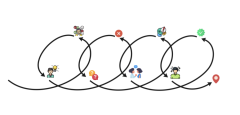CROSS, P.G., CATTELL, R.B. and BUTCHER, H.J. (1967). The Personality Pattern of Creative Artists. British Journal of Educational Psychology, [online] 37(3), pp.292–299. Available at: https://bpspsychub.onlinelibrary.wiley.com/doi/10.1111/j.2044-8279.1967.tb01944.x [Accessed 22 Apr. 2021].
The general area and keywords of my question so far are:
Art students, Subject choice, Employment, and Future development.
In discussion with the dragon group on Wednesday, Dominic recommended a book named the way of integrity. In the introduction part, the author said that but how I, and other people, could create lives we actually enjoyed.
It also reminded me of my previous investigation: Only 4% of my earlier classmates are doing art-related jobs now, while others change their careers. Then I found that although they didn’t choose the art-related job, they did find jobs. It makes me think of a question: should we do what we like or like what we do?
In addition, art students are a more sensitive group: Sixty‐three visual artists and twenty‐eight craft students were compared with a matched control group. Significant differences in mean scores between artists and controls were found on twelve factors of the 16PF test. On eleven of these twelve factors, the scores of the craft students were intermediate between those of the artists and the controls. Especially salient features of the artists’ personality pattern were A – (reserved, schizothyme tendency), E+ (assertiveness, dominance), Q2+ (self sufficiency), G – (low emotional stability), Q3 – (low self‐integration, casualness), M+ (autistic or bohemian tendency) and G – (low superego strength). They also differed from the control group in being more suspicious (L+), more apprehensive or guilt‐prone (O+), and more tense or overwrought (Q4+). In terms of the second order factors, the artists are assessed as being slightly introverted though there is evidence of some contradiction, strongly anxious, experimenting, non‐moralistic, and slightly sensitive (CROSS, CATTELL and BUTCHER, 1967).
Two directions of my question :
One is to help to reduce a ‘psychological gap’. How can I reduce Art students’ psychological gap when they face employment problems. This direction is more about how to tell students not to fantasize too much about an unrealistic future. (not everyone can become a famous, self-supporting artist)
The other direction is to help art students start their own businesses. I prefer to study the direction of creating personal IP.
How can I help art students build personal IP in the Internet era? This direction is mainly for those students who want to be freelance artists, illustrators, designers etc.
